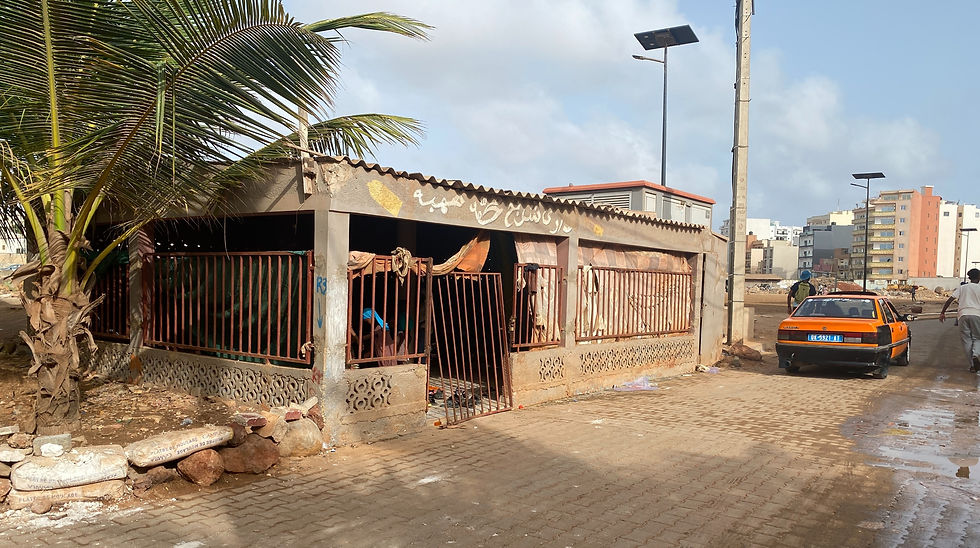Senegal Reflections 4: Schools
- rrossparker
- Aug 8, 2023
- 3 min read

What are the schools like?
Dakar is host to a wide variety of places of learning, from traditional public schools, small religious schools, universities that attract students from many countries, and historical sites that attract people from around the globe. We visited during summer break – when no Westerners in their right minds would dream of visiting – so the few public schools we encountered were empty of students and teachers, but we did have an unexpected amount of encounters with places of learning, directly and vicariously, even in our short stay in the capital.
Public Schools – From the three we saw and what we gleaned from our Dakaroise guide who grew up in the school her father led, the schools in the city were of a similar form: enclosed with walls, organized around a courtyard, and with open-air circulation spaces. Classrooms were of familiar size and shape, yet seemingly from a century ago: a single teaching wall, blackboard, teacher desk, small bookshelf, few windows, minimal ventilation, and desks and seating in rows. Two things stood out: lack of books or bookshelves, benches for two or four students, very dilapidated furniture and finishes, and a digital projector. Wifi and the use of smartphones is widespread, so it appeared that there is likely a computer or digital device that connects to the internet and the digital tools. What was missing was typical of the city: a lack of telecommunication hardwiring. We saw no gymnasia or indoor gathering spaces. Toilets were in single stalls in the courtyards with open-air sinks. For schools of over a hundred students, there were four stalls for students.
Public School, Ngor village:


inside the courtyard with many murals and banyan trees:

caretaker and goat:

Public School, Île Gorée:





Religious Schools – In summer many younger students attend day schools run by the local mosques. Two we saw in session were providing Arabic lessons to understand the Koran. One was a small courtyard - really just a widening in the 5-10 foot wide pedestrian street - covered in a tent and the other a very small dilapidated building directly on a busy street next to a dirt field. Both had small carpets, which looked like the small prayer rugs we saw people selling in the markets and using in shops and in quiet alcoves. Shoes were left at the entries.
Summer day school in the heart of Ngor village


Summer day school next to Ngor village:

traffic controls is self-performed, but effective

learning space is at the street

adjacent play field

Higher Education – We didn’t visit any campuses, but saw two of the five main university campuses in the city. We spent an evening with two friends of my Seattle-based colleague, each of whom had left their home countries over 2,000 miles away in Central Africa to obtain a masters degree which were not offered closer to their home. Both had graduated and stayed behind to work and to become entrepreneurs in Dakar’s burgeoning IT sector. They had been there for 7 and 10 years, respectively. Most of the campus buildings we saw were fairly modern and appeared to be in good condition.


The island of Gorée – The name means “Good Raid”, and the place is today a UNESCO World Heritage Site and one of the most renowned places in West Africa. From the 15th to the 19th century it was the largest slave-trading centre on the African coast. Ruled in succession by the Portuguese, Dutch, English and French, its architecture is characterized by the contrast between the grim slave-quarters and the elegant houses of the slave traders. Today it continues to serve as a place of learning – “a pilgrimage destination for the African diaspora, a foyer for contact between the West and Africa, and a space for exchange and dialogue between cultures through the confrontation of ideals of reconciliation and forgiveness.” What was a place of horror for Africans – and of commerce and living for the foreign overseers - has been preserved and refreshed into a place suitable for visitors.
As a place of learning, it was a powerful experience. While heavily sanitized from when it operated, it demonstrates the power of an immersive experience .


More to follow.
Comments